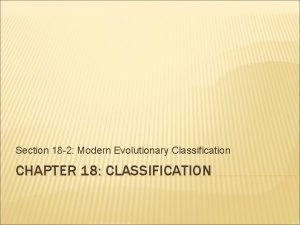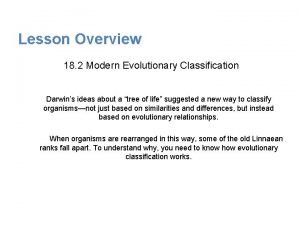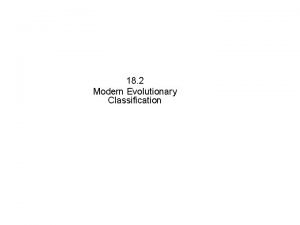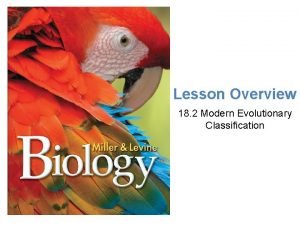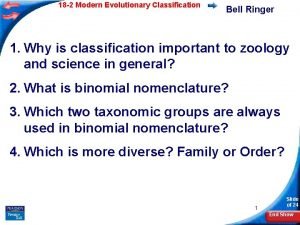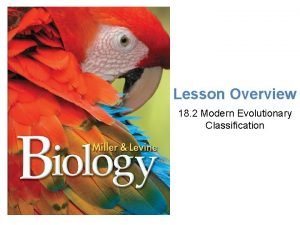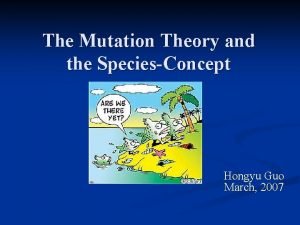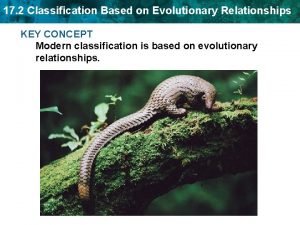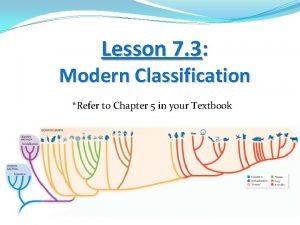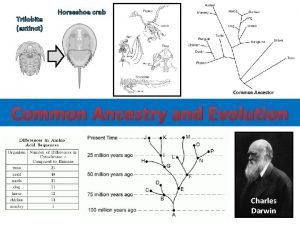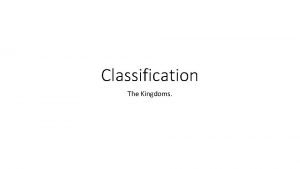Modern Evolutionary Classification 18 2 Modern Evolutionary classification













- Slides: 13

Modern Evolutionary Classification 18. 2

Modern Evolutionary classification • Taxonomic groups are invented by scientist to group organisms with similar characteristics

Which Similarities are most important • Taxonomists try to group organisms according to biologically important characteristics – Linnaeus grouped species based on visible similarities (Dolphin example: Fish vs. Mammal) Barnacle crab limpet

Evolutionary Classification Limpet and barnacle larvae are very different. • Barnacles have jointed limbs, Limpets DON’T ! • Barnacles have a segmented body, Limpets DON’T ! • Barnacles have an exoskeleton that molts, Limpets DON’T !

Evolutionary Classification Crab and barnacle larvae are very similar • Barnacles have jointed limbs, So do CRABS ! • Barnacles have a segmented body, So do CRABS ! • Barnacles have an exoskeleton that molts, So do CRABS !

Evolutionary Classification • Organisms are grouped together based on evolutionary decent not just physical traits (WHY? ? ) • The higher the level of the taxon, the further back in time is the common ancestor

Evolutionary Classification • Evolutionary classification helps scientist to know how one lineage branched from another

Lion • Kingdom: Animalia • Phylum: Chordata • Class: Mammalia • Order: Carnivora • Family: Felidae • Genus: Panthera • Species: leo Tiger • Kingdom: Animalia • Phylum: Chordata • Class: Mammalia • Order: Carnivora • Family: Felidae • Genus: Panthera • Species: tigris

Lion • Kingdom: Animalia • Phylum: Chordata • Class: Mammalia • Order: Carnivora • Family: Felidae • Genus: Panthera • Species: leo Grey Wolf • Kingdom: Animalia • Phylum: Chordata • Class: Mammalia • Order: Carnivora • Family: Canidae • Genus: Canis • Species: C. lupus

Cladistic analysis • A way of classifying organisms using only new evolutionary characteristics • Derived characteristics - These characteristics appear in later organisms but not earlier ones • Cladogram: a diagram used to show evolutionary relationships

Cladogram • Help us to understand how one lineage branched from another in the course of evolution. (family tree)

1. ______ Wings 2. ______ 6 Legs 3. ______ Segmented Body 4. ______ Double set of wings 5. ______ Jumping Legs 6. ______ Crushing mouthparts 7. ______ Legs 8. ______ Curly Antennae

Answer 1. ___F___ Wings 2. ___C___ 6 Legs 3. ___A___ Segmented Body 4. ___G___ Double set of wings 5. ___E___ Jumping Legs 6. ___D___ Crushing mouthparts 7. ___B___ Legs 8. ___H___ Curly Antennae
 18-2 modern evolutionary classification
18-2 modern evolutionary classification 18.2 modern evolutionary classification
18.2 modern evolutionary classification 19.2 modern evolutionary classification
19.2 modern evolutionary classification 18-2 modern evolutionary classification
18-2 modern evolutionary classification Red panda life cycle
Red panda life cycle Wolf classification
Wolf classification Modern evolutionary classification
Modern evolutionary classification Modern evolutionary synthesis
Modern evolutionary synthesis Classification based on evolutionary relationships
Classification based on evolutionary relationships Classification based on evolutionary relationships
Classification based on evolutionary relationships Traditional classification vs modern classification
Traditional classification vs modern classification Psychological perspective
Psychological perspective Evolutionary fuzzing
Evolutionary fuzzing Trilobite and horseshoe crab
Trilobite and horseshoe crab
